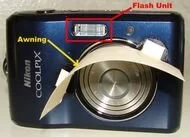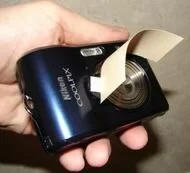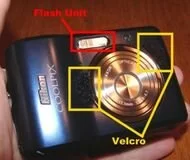How to Make and Use a Dust Awning to Reduce Dust Orbs in Photos...
False orbs can be created by dust in front of the camera lens, so if one wants to reduce the amount of dust particles that are reflecting the flash directly in front of the lens, we suggest making a dust awning.
Many digital cameras have a flush face with the flash unit being located beside the lens, so dust is easily illuminated while photographing and is often captured in photos as specks of light. Dust orbs can be eliminated or at least reduced by shielding the lens from the flash just a little bit.
How to Make a Dust Awning for Your Camera
Although it would be better to just buy a camera with the flash unit further away from the lens, most of us do not have that luxury. So, we recommend a non-invasive alteration to your point-and-shoot digital camera that anyone can do. All you will need is either a thin sheet of plastic or some heavy card stock. We do recommend that the sheet be opaque if possible to block the light better. Also, we found that stick-on Velcro works best for affixing the dust awning to your camera. This way, you can remove it when not needed.
What you want to do is cut out a rectangular piece from your sheet with two or more small tabs. Place small pieces of Velcro on the tabs (and attach the other half of the Velcro to your digital camera in the appropriate spots to create a little awning above the camera lens, but beneath the flash and IR light). Be careful that the awning does not obstruct the lens if it telescopes out of the camera, and make sure it is not visible in your photograph. Also, check to see if it casts a shadow on your picture. If it does, it will need to be narrowed, a bit. We created a .pdf file template which you can download and print: Dust Orb Awnings. This may or may not help, but it will give you a place to start. Your dust awning will have to be cut and fitted by you to make it function properly. Also see: Get Rid Of Dust Orbs.
In our tests, the dust awning dramatically reduced the amount of dust orbs we captured in our photographs. Below, are photos of our modified dust awning for a Nikon CoolPix camera:

Our Nikon CoolPix camera has a telescoping lens. We created the dust awning out of cardstock and used Velcro to attach it to the camera. The awning blocks the flash by forming a wall between the lens and flash unit.
 Picture two shows the dust shield from a different angle. The tabs are attached to Velcro buttons which have a sticky back. The Velcro sticks easily to the dust awning and the camera body. Should we need to, it is easy to just peel the Velcro off of the camera surface. The Velcro also make the awning detachable in case we do not want to use the dust orb awning. Of course, a black awning would look nicer than our manila prototype!
Picture two shows the dust shield from a different angle. The tabs are attached to Velcro buttons which have a sticky back. The Velcro sticks easily to the dust awning and the camera body. Should we need to, it is easy to just peel the Velcro off of the camera surface. The Velcro also make the awning detachable in case we do not want to use the dust orb awning. Of course, a black awning would look nicer than our manila prototype!
 When we remove the dust awning, we are left with only our tabs of Velcro. This makes it easy to snap on and off if we are going to be taking photographs with the flash unit!
When we remove the dust awning, we are left with only our tabs of Velcro. This makes it easy to snap on and off if we are going to be taking photographs with the flash unit!
 Note: Our Nikon digital camera has a telescoping lens. Be sure your awning does not get in the way of the lens when it extends; if so, then adjust the dustawning. If our awning were any wider, it would appear in the edges of our photographs, and cast a shadow in our pictures that could be misinterpreted as being a shadow ghost.
Note: Our Nikon digital camera has a telescoping lens. Be sure your awning does not get in the way of the lens when it extends; if so, then adjust the dustawning. If our awning were any wider, it would appear in the edges of our photographs, and cast a shadow in our pictures that could be misinterpreted as being a shadow ghost.

